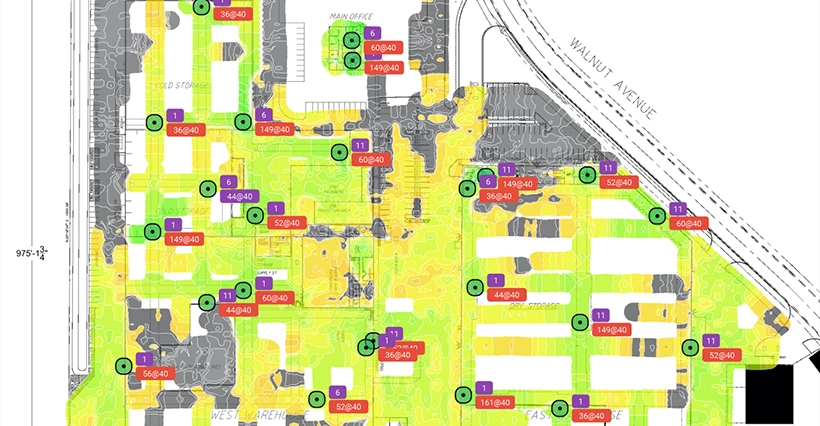Wireless Site Survey Checklist and Best Practices
Park Place Professional Services
Once upon a time, WLANs and LANs were hardwired. Miles of cable snaked through walls, floors, and ceilings to connect workstations within an organization to servers, switches, routers, and other physical network assets. Today, that is changing. While hardwired networks still exist, wireless technology offers greater flexibility and other benefits.
However, creating a wireless local area network (WLAN) can be challenging. A wireless site survey offers the best starting point but conducting such a survey requires that you follow specific steps.
Jump-to Section
What Is a Wireless Site Survey?
Benefits of Conducting a Site Survey
Wireless Site Survey Checklist
Assess Existing Networking Infrastructure
We’ve created a wireless site survey checklist to help streamline your process, as well as codify best practices to guide you on the way.
What Is a Wireless Site Survey?
In the world of networking, wireless site surveys are nothing more than a process designed to ensure that a wireless network will provide optimal coverage and support the best possible performance. It can help you determine things like how many access points are needed, where they should be located, and spot areas of potential interference. But most importantly, it provides a current view of how your wireless infrastructure is performing.

The driving factor behind conducting a site survey is usually a hardware refresh of your wireless infrastructure. You are likely interested in updating to the latest and greatest to minimize latency and improve productivity. In less common cases, you might be pursuing a wireless site survey to remediate a specific issue that a section of your building has been experiencing.
Regardless of your motivations, there are countless reasons you could be interested in learning more about wireless site survey best practices.
Benefits of Conducting a Site Survey
Why conduct a wireless site survey? The goal is to understand and validate wireless issues and develop an actionable plan. Here are just a few benefits:
- Gain insight into the existing performance
- Identify the best locations and types of access points for deployment
- Identify trouble areas
- Draft solutions and next steps for remediation
Site Survey Types
Depending on the scope of the network, as well as the demands that will be placed on it, you’ll need to choose between different types of site surveys.
Passive Site Survey
A passive site survey is conducted in listen-only mode and does not associate the survey client to the access point. This does not affect your production at all.
Predictive Site Survey
Predictive site surveys use software to predict the optimal location for access points based on known information about RF interference.
AP on a Stick
The data collection is like a Passive Survey but now the tech is using the customer’s desired future state APs & Antennas. This is like having a sneak peek into the future deployment of your wireless infrastructure.
Validation Survey
A validation survey is typically used for wireless infrastructure post-installation and is used to compare predictions to real performance. This can also be used for self-deployment scenarios when you need to gauge performance after installation.
Wireless Site Survey Checklist
Understanding how to do a wireless site survey can help you prepare your organization for a project engagement with an experienced wireless refresh company. Below, you’ll find our Wi-Fi site survey checklist. Learn these site survey guidelines for WLAN development before your project begins:
Identify Needs
What are you hoping to accomplish by having a Wi-Fi site survey done? Is your refresh technology-driven for higher productivity? Or has the bulk of your existing infrastructure reached its EOSL date, and you are exploring a wireless network refresh alongside a third-party network hardware maintenance contract?
Before taking any other site survey steps, you’ll need to identify your network requirements. What sort of speed and bandwidth will be required? How many human resources and workstations are you expecting to support?
Obtain Floor Plans
Once you have the specifications in hand, the next step on our Wi-Fi assessment checklist is to obtain floor plans for the environment. If possible, building blueprints should be used. Note the location of permanent site features like stairs, elevators, and things that might affect wireless signal.
Perform Walkthrough
Physically walking the site provides insight into things that you cannot gain remotely such as identifying equipment racks, modular walls, varying heights of inventory, etc.

Assess Existing Networking Infrastructure
What does the current networking infrastructure like? Does it need to be rebuilt from the ground up? Can you use it as a base and expand on it? Where can you install wireless access points and how close are those to existing wired network closets and other infrastructure elements? These are all questions you need to carefully consider when assessing your existing networking infrastructure.
Determine Coverage Areas
The next step is to identify the key areas for coverage. Where will users require the most bandwidth? The most common key points include meeting rooms, offices, executive areas, and production areas like loading docks.
Decide on Access Point (AP) Locations
Now it is time to rough out your access point locations and check the coverage range for each one. Make sure there is overlap between neighboring points to balance loads and ensure network resilience.
Refine AP Locations
Based on the results of your survey in the previous step, refine the locations of your access points based on the project requirements and best practices. This point in the process is where AP on a Stick site survey methods are especially handy.

Record Findings
The last step when conducting a wireless site survey is to document your findings and recommendations. Taking the extra time to record what you have found will help to identify your current state and where your wireless design is headed.
Wireless Site Survey Best Practices
Aside from following the above steps and finding the right expert to perform your wireless site survey, there are other issues to consider. As a site owner or IT administrator, it is imperative that you also consider the following site survey guidelines for WLAN deployment:
- Always plan for overlap between wireless access points to ensure smooth streaming. Map out coverage so that you can clearly see areas where overlap may be weakest.
- When designing wireless networks, make sure that wireless access points don’t use a transmit power greater than what client devices can handle.
- Map out the environment’s “noise floor,” which is a mixture of all background RF radiation within the environment.
- Carefully map out the most critical areas for wireless signal (poor signal to the executive suite can spell disaster).
- Accurately identify all potential sources of interference that might block or weaken the wireless signal.
- Create clear, legible plans that can be easily followed during installation.
- Analyze the data to pinpoint any areas where the network is faltering; filtering results by turning off certain channels will help with interference.
The Future of WLAN Deployment
The network infrastructure of the future is increasingly interconnected and flexible. Organizations will tolerate less interference and insist on greater uptime and connectivity, even at remote locations within their environment. Furthermore, you can bet that security (both physical and software-based) will increase in importance as bad actors, malware, and viruses continue to increase.
The Right Partner Can Help You Perfect Your Wireless Network
The site survey is an integral precursor to the implementation and optimization of a wireless network. Park Place Technology’s Wireless Transformation service leads organizations through wireless modernization by leveraging our three-phase Assessment & Design, Build & Ship, and Deployment process on a global scale. We provide a complete end-to-end solution, from onsite wireless survey (coverage heatmaps), optimized designs, to new cabling and AP installation with validation surveys.
However, if a complete wireless refresh is not your immediate need, Park Place’s Data Center Professional Services can address several ad hoc project needs as well, such as: new office/warehouse deployments, WLAN security assessments, user connectivity and WLAN performance issue identification, and resolution and wireless optimization. Plus, our platform-neutral approach means we are not tied to a specific manufacturer solution. Rather, we are aligned to your unique environment, goals, and budget. And our approach is flexible, allowing you to leverage only the service components that you need, which helps to manage costs.
Regardless of your needs, our global data center and networking optimization firm is here to help. Contact Park Place Technologies to learn more about our Wireless Transformation services and get started on conducting your wireless site survey today!



